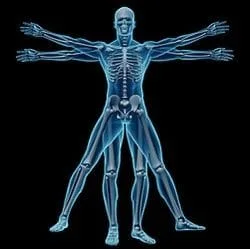
The human back is composed of a series of complex structures that work together to allow you to perform your daily activities. When functioning correctly, your spinal musculature is incredibly strong, supportive, and flexible through all planes of motion.
Unlike many muscles in your body, the muscles of your back are always active and in continuous use. These muscles form an essential part of your core musculature and act to:
- Help you maintain your posture in a neutral position so that your body can effectively distubute stresses placed upon it.
- Hold your toso in an upright position.
- Form the fulcrum through which the force required to move your arms and legs is generated.
A back that is not impeded in its movement, with strong flexible muscles, is essential for you to perform your normal daily tasks without adding numerous internal stresses to your body.
The Human S-Curve
The design of the human back is unique in the way it is able to distribute weight and provide balance while maintaining an upright posture. Your spine is aligned with three natural curves that form an S-shape when you are standing. The S-shape curve of your spine oscillates during any activity (such as walking) and enables the spine to function as a shock absorber.
When your back is properly aligned, your ear, shoulder, and hip form a straight line. If the muscles of your back are weak, stressed, or constricted, you will lose this natural S-shape, affect your good posture and limit your ability to carry out normal tasks in comfort.
What makes a person more susceptible to back pain?
- Atherosclerosis
- Smoking
- Medications
- Normal Aging Process
- Pregnancy
- Chronic Inflammatory Conditions
- History of Trauma
- Lack of Core Stability
- Osteoarthritis
- Repetitive Motion
- Excess Weight
- Infection
- Muscular Imbalances
- Osteoporosis
- Scar Tissue
Your spine performs many critical functions in your back. The spine:
- Contains and protects the spinal cord.
- Allows a full range of motion. Your spine is not meant to be rigid.
- Acts as an attachment site for the muscles and ligaments of the back. Any restrictions in these attached soft-tissue can cause biomechanical imbalances that affect the functioning of the spine.
Discs are the spine's shock absorption mechanism and lie between, and are attached to, vertebrae of the backbone, and form part of the front wall of the spinal canal. Discs are designed to:
- Absorb huge amounts of stress.
- Act as a hinge, permitting increased range of motion and mobility in the spine.
- Protect the spinal cord and its nerve roots.
Soft Tissue Layers of the Back
Your back is composed of multiple layers of tissue which can be divided into three major layers; superficial, intermediate, and deep. These multiple layers, combined with the musculature of the abdomen and a vast number of tendons and ligaments, form the core of your body. When under stress, or due to repetitive actions, these core layers of soft-tissue can adhere to each other. These adhesions cause biomechanical imbalances which eventually lead to friction, inflammation and physical dysfunction of the spine.
